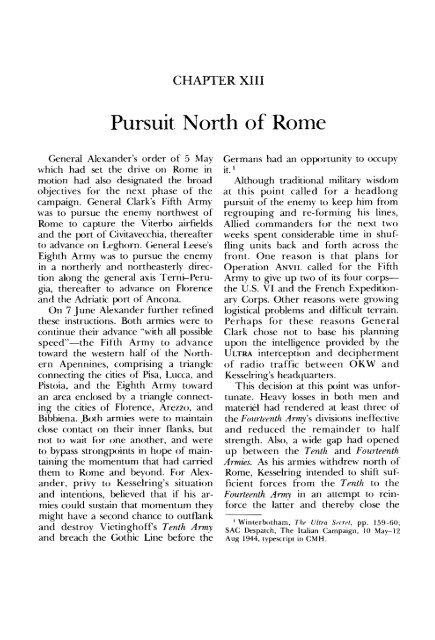Cassino to the Alps - US Army Center Of Military History
Cassino to the Alps - US Army Center Of Military History
Cassino to the Alps - US Army Center Of Military History
You also want an ePaper? Increase the reach of your titles
YUMPU automatically turns print PDFs into web optimized ePapers that Google loves.
CHAPTER XIII<br />
Pursuit North of Rome<br />
General Alexander's order of 5 May<br />
which had set <strong>the</strong> drive on Rome in<br />
motion had also designated <strong>the</strong> broad<br />
objectives for <strong>the</strong> next phase of <strong>the</strong><br />
campaign. General Clark's Fifth <strong>Army</strong><br />
was <strong>to</strong> pursue <strong>the</strong> enemy northwest of<br />
Rome <strong>to</strong> capture <strong>the</strong> Viterbo airfields<br />
and <strong>the</strong> fXJrt of Civitavecchia, <strong>the</strong>reafter<br />
<strong>to</strong> advance on Leghorn. General Leese's<br />
Eighth <strong>Army</strong> was <strong>to</strong> pursue <strong>the</strong> enemy<br />
in a nor<strong>the</strong>rly and nor<strong>the</strong>asterly direction<br />
along <strong>the</strong> general axis Terni-Perugia,<br />
<strong>the</strong>reafter <strong>to</strong> advance on Florence<br />
and <strong>the</strong> Adriatic fXJrt of Ancona.<br />
On 7 June Alexander fur<strong>the</strong>r refined<br />
<strong>the</strong>se instructions. Both armies were <strong>to</strong><br />
continue <strong>the</strong>ir advance "with all fXJssible<br />
speed"-<strong>the</strong> Fifth <strong>Army</strong> <strong>to</strong> advance<br />
<strong>to</strong>ward <strong>the</strong> western half of <strong>the</strong> Nor<strong>the</strong>rn<br />
Apennines, comprising a triangle<br />
connecting <strong>the</strong> cities of Pisa, Lucca, and<br />
Pis<strong>to</strong>ia, and <strong>the</strong> Eighth <strong>Army</strong> <strong>to</strong>ward<br />
an area enclosed by a triangle connecting<br />
<strong>the</strong> cities of Florence, Arezw, and<br />
Bibbiena. ,Both armies were <strong>to</strong> maintain<br />
close contact on <strong>the</strong>ir inner flanks, but<br />
not <strong>to</strong> wait ()r one ano<strong>the</strong>r, and were<br />
<strong>to</strong> bypass strongpoints in hope of maintaining<br />
<strong>the</strong> momentum that had carried<br />
<strong>the</strong>m <strong>to</strong> Rome and beyond. For Alexander,<br />
privy <strong>to</strong> Kesselring's situation<br />
and intentions, believed that if his armies<br />
could sustain that momentum <strong>the</strong>y<br />
might have a second chance <strong>to</strong> outflank<br />
and destroy Vietinghoffs Tenth <strong>Army</strong><br />
and breach <strong>the</strong> Gothic Line before <strong>the</strong><br />
Germans had an opportunity <strong>to</strong> occupy<br />
it. 1<br />
Although traditional military wisdom<br />
at this point called for a headlong<br />
pursuit of <strong>the</strong> enemy <strong>to</strong> keep him from<br />
regrouping and re-forming his lines,<br />
Allied commanders for <strong>the</strong> next two<br />
weeks spent considerable time in shuffling<br />
units back and forth across <strong>the</strong><br />
front. One reason is that plans for<br />
Operation ANVIL called for <strong>the</strong> Fifth<br />
<strong>Army</strong> <strong>to</strong> give up two of its four corps<strong>the</strong><br />
U.S. VI and <strong>the</strong> French Expeditionary<br />
Corps. O<strong>the</strong>r reasons were growing<br />
logistical problems and difficult terrain.<br />
Perhaps for <strong>the</strong>se reasons General<br />
Clark chose not <strong>to</strong> base his planning<br />
upon <strong>the</strong> intelligence provided by <strong>the</strong><br />
ULTRA interception and decipherment<br />
of radio traffic between OKW and<br />
Kesselring's headquarters.<br />
This decision at this fXJint was unfortunate.<br />
Heavy losses in lx)th men and<br />
materiel had rendered at least three of<br />
<strong>the</strong> Fourll'mlh Armv's divisions ineffective<br />
and reduced <strong>the</strong> remainder <strong>to</strong> half<br />
strength. Also, a wide gap had opened<br />
up between <strong>the</strong> Tenth and Fourteenth<br />
Armies. As his armies withdrew north of<br />
Rome, Kesselring intended <strong>to</strong> shift sufficient<br />
forces from <strong>the</strong> Tenth <strong>to</strong> <strong>the</strong><br />
Fourteenth <strong>Army</strong> in an attempt <strong>to</strong> reinforce<br />
<strong>the</strong> latter and <strong>the</strong>reby close <strong>the</strong><br />
1 Winterbotham, Tilt' Ultra Sf'rrpt, pp. 159-60;<br />
SAC Despatch. The Italian Campaign, 1 () May-12<br />
Aug 1944, typescript in CMH.
















